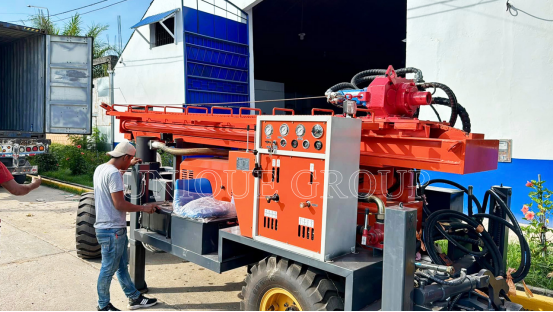What Are The Main Components Of The Hydraulic System Of a Water Well Drilling Rig And What Are Their Respective Functions?
The hydraulic system of a water well drilling rig is one of the core components that ensures the efficient and stable operation of the drilling rig. The hydraulic system realizes the operation of each moving part of the drilling rig through components such as hydraulic pumps, hydraulic cylinders, valves, etc., provides power and control, and realizes various drilling actions such as lifting, rotation, and feeding. The following are the main components of the hydraulic system of a water well drilling rig and their functions:
1.Hydraulic pump
Function:
The hydraulic pump is the power source of the hydraulic system. It provides hydraulic oil flow and pressure by converting mechanical energy into hydraulic energy. The hydraulic pump is generally driven by an engine. Its main task is to suck hydraulic oil from the oil tank and transport it to load elements such as hydraulic cylinders and hydraulic motors through pipelines.
Type:
Gear pump: commonly used in low-pressure, high-flow systems.
Plunger pump: suitable for high-pressure, high-efficiency hydraulic systems.
2.Hydraulic cylinder
Function:
The hydraulic cylinder is one of the actuators in the hydraulic system. It converts the pressure of the hydraulic oil into mechanical movement. The hydraulic cylinder realizes different actions such as lifting and propulsion by pushing various components of the drilling rig.
Type:
Single-acting hydraulic cylinder: It has force in only one direction and returns through external forces such as springs.
Double-acting hydraulic cylinder: It has force in both directions and can provide stronger control capabilities.
3.Hydraulic motor
Function:
Hydraulic motor is a component that converts hydraulic energy into mechanical energy and is used to drive the rotating parts of the drilling rig, such as drill bits, winches, etc. Hydraulic motors are usually used in occasions that require continuous rotation or speed control.
4.Hydraulic valve
Function:
Hydraulic valves are components used to control the flow direction, flow rate, pressure and flow direction of hydraulic oil. They can accurately control the actions of the hydraulic system, such as starting and stopping, adjusting oil flow, reversing, etc.
Main types:
Pressure control valve: It is used to limit the maximum pressure in the hydraulic system and protect the system from excessive pressure.
Flow control valve: It is used to adjust the oil flow and control the movement speed of the hydraulic system.
Directional control valve: It is used to change the flow direction of hydraulic oil, thereby controlling the movement of different components.
5.Hydraulic oil tank
Function:
The hydraulic oil tank stores hydraulic oil and plays a heat dissipation role. The hydraulic oil in the oil tank not only provides a continuous flow of oil for the hydraulic pump, but also plays a role in cooling, filtering and precipitating impurities.
Function:
Store oil and maintain the amount of hydraulic oil.
Provide heat dissipation and gas discharge of the oil.
Keep the oil clean and filter out impurities in the system.
6.Hydraulic pipes and joints
Function:
Hydraulic pipes are channels connecting hydraulic components for conveying hydraulic oil. Joints are connecting parts between various components to ensure the sealing and safety of oil flow in the hydraulic system.
Function:
Transmit hydraulic oil from the hydraulic pump to various actuators, such as hydraulic cylinders, hydraulic motors, etc.
Ensure that the oil flow is unobstructed during system operation and prevent leakage.
7.Hydraulic filter
Function:
Hydraulic filters are used to filter impurities and contaminants in hydraulic oil, protect hydraulic components, and ensure the stability and long-term service life of the hydraulic system.
Type:
Coarse filter: Filter large particles of impurities in the oil.
Fine filter: Filter fine particles to ensure the cleanliness of hydraulic oil.
8.Hydraulic cooler
Function:
Hydraulic cooler is used to reduce the temperature of hydraulic oil to prevent excessive oil temperature from affecting the efficiency and safety of the system. Hydraulic cooler usually consists of radiator and fan, and radiator cools down by heat exchange with ambient air.
9.Pressure gauge and flow meter
Function:
Pressure gauge: used to monitor the pressure of hydraulic system, ensure that the system works within the normal range, and prevent damage caused by excessive pressure.
Flow meter: used to monitor the flow of hydraulic oil and ensure that the oil flow meets the design requirements.

Working process of hydraulic system:
The hydraulic pump converts mechanical energy into hydraulic energy and pumps hydraulic oil into the hydraulic system.
The hydraulic oil adjusts the flow direction through the hydraulic valve and enters the hydraulic cylinder or hydraulic motor to realize the action of the actuator.
After the actuator completes the corresponding action, the hydraulic oil flows back to the tank.The hydraulic oil tank stores hydraulic oil, which is cleaned by the filter, and the oil temperature control system ensures that the oil temperature is appropriate.
Through the coordinated action of these components, the water well drilling rig can achieve efficient drilling operations and ensure the smooth progress of the operation. The design and maintenance of the hydraulic system are crucial to the stable operation of the drilling rig. Regular inspection and maintenance of the hydraulic system can help improve the service life and operating efficiency of the equipment.

